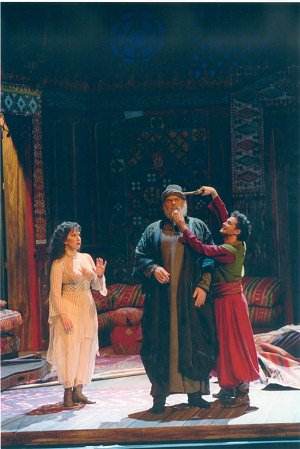This production might be known as "Il Barbiere di Kabul" by some unkind wags. Coline Serreau, the designer of this new production, has taken this opportunity to make her views known about the treatment of women in Moslem countries. In the program, her notes remind the reader that Seville was part of the Islamic Empire for 400 years or so and that the Catholic Church continued the long-standing practice of the suppression of women. Shifting the location to some unspecified Arab locale actually does not do violence to the story and serves to highlight the eventual triumph of love and freedom over confined conformity.
Serreau, whose first opera staging was last year’s controversial Die Fledermaus, is not offering a polemic tract this time. An accomplished actor and filmmaker, she knows that this opera, with the revolutionary, irreverent and irrepressible fun of the Beaumarchais play and the cork-popping effervescence of a 24-year-old Rossini, is the right vehicle to make her point with humor.
The curtain rises not on a town square but a desert with an Arabic fortress wall on the side. The Count arrives to serenade his love outfitted very much like Douglas Fairbanks in "The Thief of Baghdad." For Rosina’s brief "appearance" in this scene, you see nothing but a veil. The second scene is a splendid Arabic interior, complete with a fountain in the middle. The American mezzo Joyce DiDonato, making her debut with the Opéra, appears again covered from head to toe; only showing her face when she knows she is alone. Baritone Carlos Chausson, the Doctor Bartolo, appears in a beard and costume closely approximating that of a Taliban official but paces about á la Groucho Marx.
When Miss DiDonato sings her ‘Una voce poco fa’ she begins through a decorative grillwork in front of the stage. Later she burst through this barrier, and sings her final coloratura fireworks with evident self-affirming girl power. It was an impressive debut and she has power and vocal accuracy to spare. A confident and assured actor, she was an audience favorite.
The Bartolo of Carlos Chausson was perhaps the most musically satisfying performance. His bravura delivery and musical intelligence makes him an ideal Rossini baritone. His devilishly difficult aria ‘A un dottor della mia sorte’ was a lesson in how to sing Rossini with accuracy and style. Tenor Roberto Saccà, the Count Almaviva, was also making his debut but apparently forgot to warm up his voice before making his entrance. His first act aria began with ugly sounds and he sounded rough until he rediscovered his voice about half way through. From then on he sang agreeably, if not memorably.
The comic side of Kristinn Sigmundsson is not often seen. He is normally singing roles like the Grand Inquisitor, Klingsor and Méphistophélès but his giant frame wrapped around the role of Basilio like a glove. Serreau used him effectively and at one point had him lifting a complaining Bartolo off the ground and shaking him like a rag doll. With his awesome bass voice, it is unlikely that one will ever hear ‘La calunnia’ more forcefully declaimed.
In the title role, baritone Dalibor Jenis made a good impression and handled all of his complicated stage activity with seeming ease. His ‘Largo al factotum’ was smoothly dispatched and well received and his talented guitar playing during the Count’s serenade was only one indication of his many-sided talents. Jeannette Fischer, singing the role of Berta, sang (and danced) with gusto.
The sets, by Jean-Marc Stehlé and Antoine Fontaine, were imposing by any measure and received the accolade, rare in Paris, of applause by the audience. Else Pavanel dressed her brigade of police like a fanciful and colorful Taliban army and otherwise provided eye pleasing costumes all around. The experienced Italian conductor Bruno Campanella, in charge in the pit, kept the musical pulse firm and on target. Serreau knows how to use her mostly young cast to get a laugh without being silly and it was the right theatrical touch for this delicious masterpiece. With singing that ranged from good to great, it made for appealing evening.
Frank Cadenhead
Photo: Eric Mahoudeau.

 Return to:
Return to: